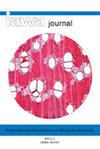热带濒危树种卡氏树的Cambium酚学和树木年表
IF 3.5
3区 农林科学
Q2 FORESTRY
引用次数: 0
摘要
ococtea catharinensis主要分布于巴西大西洋森林,受到木材采伐、森林破碎化和栖息地丧失的严重威胁。该物种的残余种群遗传丰富,这可能与长寿树木的存在有关,因此了解它们的生长和年龄是必要的。本研究分析了来自茂密伞形林的catharinensis乔木的年代学潜力、形成层活动和休眠期以及气候对年生长的影响。年轮形成明显,夏秋两季形成层活跃,冬春两季形成层休眠。从1852年至2015年建立了树木年轮宽度年表。采样树木的估计年龄从40年到164年不等。在我们的研究地点,O. catharinensis没有表现出强烈的年龄-直径关系,因此乳房高度相似的直径导致年龄差异高达50岁。树轮宽度年代学与3月降水量呈正相关,3月是雨季和旱季的过渡月份。这一研究成果为了解柽柳的生长情况带来了宝贵的贡献,这是该物种的新发现,对天然林中这些长寿树木的维护具有重要意义。本文章由计算机程序翻译,如有差异,请以英文原文为准。
Cambium phenology and dendrochronology of the endangered tropical tree Ocotea catharinensis Mez
Ocotea catharinensis occurs mainly in the Brazilian Atlantic Forest and is highly threatened by timber logging, forest fragmentation, and habitat loss. The remnant populations of this species are genetically rich, which may be related to the presence of long-lived trees, and so it is imperative to understand their growth and age. In this study, we analyzed trees of O. catharinensis from dense ombrophylous forest, its dendrochronological potential, the period of cambial activity and dormancy, and the influence of climate on annual growth. The species showed distinct annually-formed tree-rings, with cambial activity during summer and autumn, and cambial dormancy during winter and spring. A tree-ring width chronology was built from 1852–2015. The estimated age of the sampled trees varied from 40 to 164 years. O. catharinensis in our study site does not show a strong age–diameter relationship, hence similar diameters at breast height resulted in differences in ages by as much as 50 years. The resulting tree-ring width chronology is positively correlated with March precipitation, the transition month between rainy and dry seasons. This study brings valuable contributions to the understanding of the growth of O. catharinensis, which is a novelty for this species and important to the maintenance of these long-lived trees in natural forests.
求助全文
通过发布文献求助,成功后即可免费获取论文全文。
去求助
来源期刊

IAWA Journal
农林科学-林学
CiteScore
3.40
自引率
15.80%
发文量
26
审稿时长
>36 weeks
期刊介绍:
The IAWA Journal is the only international periodical fully devoted to structure, function, identification and utilisation of wood and bark in trees, shrubs, lianas, palms, bamboo and herbs. Many papers are of a multidisciplinary nature, linking
 求助内容:
求助内容: 应助结果提醒方式:
应助结果提醒方式:


